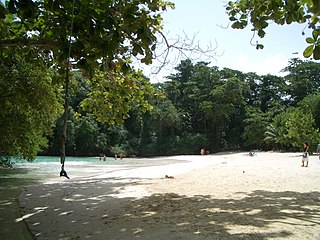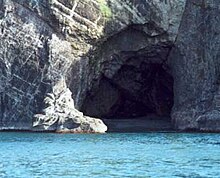
The Arawak are a group of Indigenous peoples of northern South America and of the Caribbean. Specifically, the term "Arawak" has been applied at various times from the Lokono of South America to the Taíno, who lived in the Greater Antilles and northern Lesser Antilles in the Caribbean. All these groups spoke related Arawakan languages.
Hedonism II is an adults-only vacation resort in Jamaica, owned and operated by Marshmallow Ltd, headed by Harry Lange. The resort has areas reserved for naturism and it is known for its sexually liberal culture. As of 2020, only Hedonism II is in operation. There was never a Hedonism I, and Hedonism III closed in 2010.

Papillon is a 1973 epic historical drama prison film directed by Franklin J. Schaffner. The screenplay by Dalton Trumbo and Lorenzo Semple Jr. was based on the 1969 autobiography by the French convict Henri Charrière. The film stars Steve McQueen as Charrière ("Papillon") and Dustin Hoffman as Louis Dega. Because it was filmed at remote locations, the film was quite expensive for the time ($12 million), but it earned more than twice that in its first year of release. The film's title is French for "Butterfly", referring to Charrière's tattoo and nickname.

The Ciboney, or Siboney, were a Taíno people of Cuba, Jamaica, and the Tiburon Peninsula of Haiti. A Western Taíno group living in Cuba during the 15th and 16th centuries, they had a dialect and culture distinct from the Classic Taíno in the eastern part of the island, though much of the Ciboney territory was under the control of the eastern chiefs. Confusion in the historical sources led 20th-century scholars to apply the name "Ciboney" to the non-Taíno Guanahatabey of western Cuba and various archaic cultures around the Caribbean, but this is deprecated.

Negril is a small, widely dispersed beach resort and town located in Westmoreland and Hanover parishes at the far western part of Jamaica, 80.8 kilometres (50.2 mi) southwest from Sangster International Airport in Montego Bay.

Westmoreland is the westernmost parish in Jamaica, located on the south side of the island. It is situated south of Hanover, southwest of Saint James, and northwest of Saint Elizabeth, in the county of Cornwall. The chief town and capital is Savanna-la-Mar. Negril, a famous tourist destination, is also situated in the parish.

The Parish of Manchester is a parish located in west-central Jamaica, in the county of Middlesex. Its capital, Mandeville, is a major business centre. Its St. Paul of the Cross Pro-Cathedral is the episcopal see of the Latin Catholic Diocese of Mandeville.

Sandals Resorts is a Jamaican operator of all-inclusive couples resorts in the Caribbean. The company is a part of Sandals Resorts International (SRI), which also operates Beaches Resorts, Fowl Cay Resort, and several private villas. Founded by Jamaican-born entrepreneur Gordon "Butch" Stewart in 1981, SRI is based in Montego Bay, Jamaica and is responsible for development, service standards, training, and day-to-day operations of the resorts.

Hanover is a parish located on the northwestern tip of the island of Jamaica. It is a part of the county of Cornwall, bordered by St. James in the east and Westmoreland in the south. With the exception of Kingston, it is the smallest parish on the island. Hanover is the birth parish of Alexander Bustamante, labour leader, first head of government of Jamaica under universal suffrage, and one of seven Jamaican National Heroes. Its capital is Lucea.

Lucea is a coastal town in Jamaica and the capital of the parish of Hanover.
At the time of first contact between Europe and the Americas, the Indigenous peoples of the Caribbean included the Taíno of the northern Lesser Antilles, most of the Greater Antilles and the Bahamas, the Kalinago of the Lesser Antilles, the Ciguayo and Macorix of parts of Hispaniola, and the Guanahatabey of western Cuba. The Kalinago have maintained an identity as an indigenous people, with a reserved territory in Dominica.
Petersfield is a small town in Westmoreland Parish, Jamaica. It shares its name with five other places in Jamaica.

Frenchman's Cove Resort, previously known as Frenchman's Cove Hotel, is a hotel located on a 42-acre (170,000 m2) property near Port Antonio on Jamaica's northeastern shore. It is considered to be the world's first all-inclusive hotel with a history indicating its role in Jamaica's tourism industry.
The Green Grotto Caves are show caves and a prominent tourist attraction on the north coast of Jamaica. Named for the green algae that cover its walls, the structure of the cave is strikingly different from inland systems; the cave is a Flank Margin Cave with two well-defined levels apparently indicating two periods with differing sea-levels. The innermost cavern contains a crystal-clear underground lake.
Jackson's Bay Cave is a very large cave on the Portland Ridge in Clarendon near the south coast of Jamaica. It is considered to be one of the most beautiful in the Caribbean. It was discovered in 1964. It is part of the Jackson bay cave system, consisting of 14 unconnected caves, and over 9200m of cumulated caves passages mapped since then. The longest of them, Jackson Bay Great Cave is over 3.360 kilometres (2.088 mi) long.

The Taíno were a historic Indigenous peoples of the Caribbean, whose culture has been continued today by Taíno descendant communities and Taíno revivalist communities. At the time of European contact in the late 15th century, they were the principal inhabitants of most of what is now Cuba, the Dominican Republic, Jamaica, Haiti, Puerto Rico, the Bahamas, and the northern Lesser Antilles. The Lucayan branch of the Taíno were the first New World peoples encountered by Christopher Columbus, in the Bahama Archipelago on October 12, 1492. The Taíno spoke a dialect of the Arawakan language group. They lived in agricultural societies ruled by caciques with fixed settlements and a matrilineal system of kinship and inheritance. Taíno religion centered on the worship of zemis.
Tensing Pen Resort is located on the western tip of Jamaica in the town of Negril. It was founded in the early 1970s as a haven and retreat for young couples. In 1975, it was purchased by Karin and Richard Murray.

Couples Resorts is one of the pioneers of the all-inclusive resort concept in the Caribbean. Couples Resorts owns and operates four all-inclusive, couples-only beach resorts on Jamaica’s north coast, between Ocho Rios and Negril.














